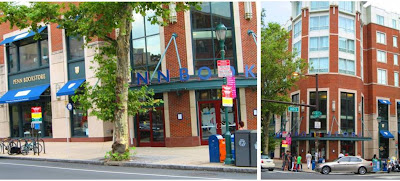Situated to the west of downtown Philadelphia just across the Schuylkill River, the
University of Pennsylvania blends old-style architecture and verdant fields on its Ivy League campus. Also, as discussed further down, Penn is home to two of the most storied athletic facilities in the U.S.
Entering Penn from its northeast corner (33rd and Chestnut streets) after crossing the street from neighboring Drexel University, as I did, one encounters a walkway in the area of Hill Square and Hill College House. Here's a
Penn map to help orient oneself to the campus.
If one were to walk along the grass to the right (west) of the walkway, one would find Silverman Hall, home of Penn Law School.
Walking south on 34th St. from in front of the Law School brings us to
Irvine Auditorium, a performing-arts facility with a
spire-type architectural style, at the corner of 34th and Spruce.
Spruce St. forms the northern border of Penn's medical/hospital complex, a mark of distinction for the university as Penn created the nation's
first medical school. The following montage highlights Penn Medicine.
The "classical" looking building in the lower right of the montage is the Hospital of the University of Pennsylvania (HUP), located right on Spruce. Further south are the Smilow Research Center and Penn Tower (the latter combining medical offices and hotel rooms for families of patients at the nearby hospitals). The Children's Hospital of Philadelphia, which forms the unfortunate acronym
CHOP, is also in the area.
Near the medical facilities, along Penn's eastern edge, are the two athletic facilities I alluded to. Shown first is Franklin Field, home to the Penn Quakers football team and also to one of the world's premier track meets, the
Penn Relays, held every spring. A statue of Benjamin Franklin stands outside Franklin Field (I used different brightnesses on the statue of Franklin and on the podium, in order to make each stand out as sharply as possible).
Next door is the Palestra, home to Penn basketball and other indoor sports (on the day I visited, the floor was configured for volleyball). What makes the Palestra famous is that it not only hosts Penn basketball games, but also used to host contests between any two "Big 5" Philadelphia college rivals -- Penn, LaSalle, St. Joseph's, Temple, Villanova -- who happened to play each other (see this
Big 5 historical website). In more recent years, however, whenever two of the schools other than Penn have played each other, the games have usually been played on one of the schools' campuses. This upcoming season, for example, LaSalle will be playing Villanova at Villanova's campus and St. Joe's will play Temple on Temple's campus. The Palestra also has a tradition of fans
throwing streamers on the court after their team scores its first basket.
Finally, heading back toward the north end of campus, there are at least two more locations of note. One is Locust Walk (named after the street, and perhaps locust trees, but presumably not locust insects). Locust Walk is a major pathway on campus, leading to its western edge.
The other is the Penn Bookstore, a huge multi-story facility. To the left in the montage below is the bookstore along Walnut St, and to the right is the cylindrical foyer at the corner of Walnut and 36th.













